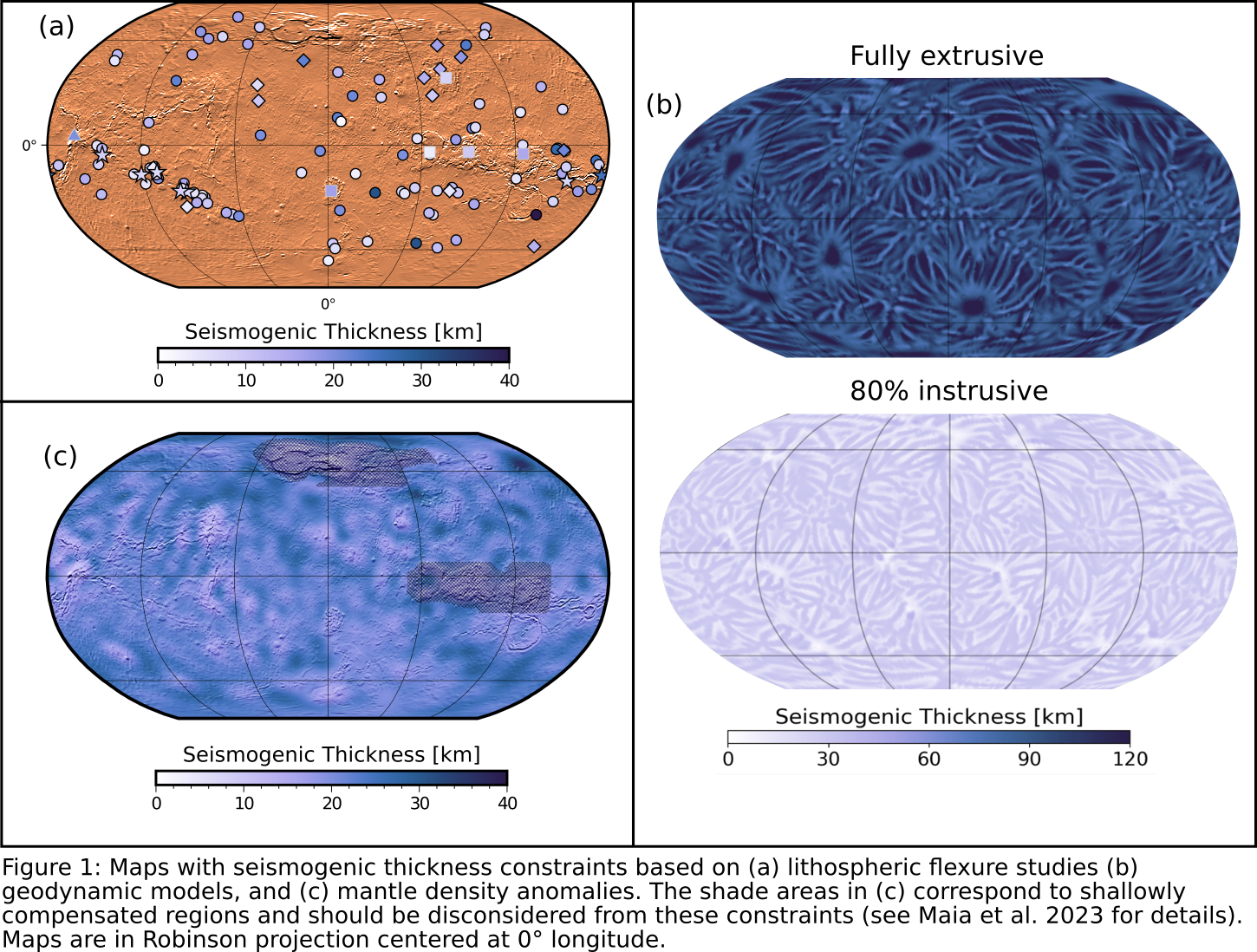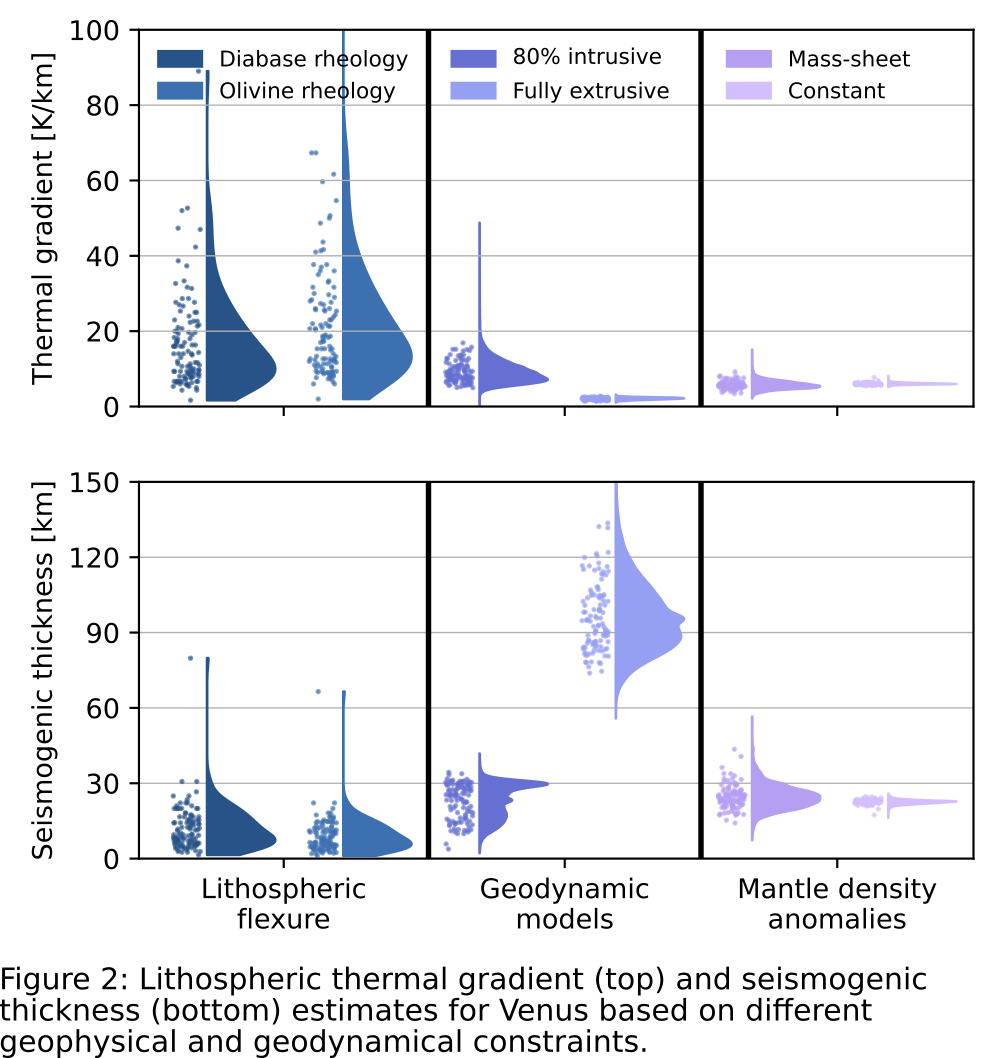Constraining the Seismogenic Thickness of Venus
- 1DLR Institute of Planetary Research , Planetary Physics, Berlin, Germany (julia.maia@dlr.de)
- 2Centre of Astronomy and Astrophysics, Technical University of Berlin
- 3NORSAR, Kjeller, Norway
- 4Department of Geosciences, Università degli studi di Padova, Padova, Italy
- 5Institut Supérieur de l'Aéronautique et de l'Espace/SUPAERO, Toulouse University, France
- 6Royal Holloway, University of London, London, UK
- 7California Institute of Technology, Pasadena, CA, United States
- 8Jet Propulsion Laboratory, California Institute of Technology, Pasadena, CA, United States
- 9School of Earth Sciences, University of Bristol, Bristol, UK
- 10Université Paris Cité, Institut de Physique du Globe de Paris, CNRS, Paris, France
- 11Institute of Geophysics, Department of Earth Sciences, ETH Zürich, Switzerland
- 12LATMOS/IPSL, Sorbonne Universit́e, UVSQ Universite Paris-Saclay, CNRS, Paris, France
- 13Department of Informatics, University of Oslo, Oslo, Norway
The surface of Venus presents a large variety of tectonic structures, from rift zones that extend thousands of kilometers [1], to globally spread wrinkle ridges [2] and coronae that could be associated with regional subduction [3]. In addition, there is a growing number of observations that point towards a geologically active Venus at present-day [4,5]. Therefore, it is highly likely that Venus is currently a seismically active planet. Yet, very little is known about the seismicity of Venus, mostly due to the lack of seismic data. Meanwhile, taking other geophysical constraints, we can start investigating some seismic properties of Venus. These analyses are essential for the planning of potential future seismic-focused missions to Venus.
A fundamental property to characterize possible seismicity levels of a planet is the thickness of the seismogenic zone, which corresponds to the upper, more brittle part of the planet where rocks can break and release seismic energy. The seismogenic thickness is closely related to the thermal structure of the lithosphere and it is usually defined by an isotherm. This study compiles estimates of lithospheric thermal gradients from geodynamic models and geophysical observations with the goal of obtaining a holistic view of the lithospheric thermal structure and seismogenic zone thickness of Venus. Here we adopt the 600°C isotherm as the seismogenic thickness, based on what has been measured for the Earth [6].
We use three independent approaches to investigate the thickness of the seismogenic zone on Venus. In the first approach, we compile a range of local elastic thickness constraints based on flexural analysis using topography and gravity data from different studies [7,8,9,10]. These elastic thickness estimates are then used to compute lithospheric thermal gradients which, in turn, allow us to determine locally the depth of the 600°C isotherm. Considering a strain rate of 1e-16 s-1 and a dry diabase rheology [11] we found that seismogenic thickness values range from 4 to 30 km, as shown in Figure 1a.
In a second approach we use 3D geodynamic thermal evolution models to assess the thermal structure of present-day lithosphere considering two distinct end-member magmatic scenarios [12]. In one case, we consider fully extrusive magmatism, i.e., all melt produced in the mantle is extracted to the surface. On the second case, 80% of the melt remains trapped within the lithosphere at 50 km depth. These scenarios lead to completely distinct lithospheric structure (see Figure 1b). Extrusive magmatism builds an extremly thick and cold lithosphere aassociated with seismogenic thicknesses of 60-150 km, while a high level of intrusions results in a thin and warm lithosphere, with seismogenic thickness values of 5-40 km.
Finally, we obtain seismogenic thickness estimates associated with constraints on mantle density anomalies from geophysical inversions using gravity and topography data [13]. In this case, the density anomalies are assumed to be caused by mantle temperature anomalies via the relation , where is the thermal expansivity, is the reference mantle density and correspond to latitude and longitude. These mantle temperature anomalies cause temperature variations at the base of the thermal lithosphere which, in turn, affect the lithospheric thermal gradient and the seismogenic thickness. Since these constraints are only sensitive to lateral variations of temperature and not the absolute temperature, to constrain the seismogenic thickness we use the intrusive geodynamic model as a reference temperature profile. Figure 1c shows the seismogenic thickness map, using K-1 and kg/m3. In this approach, the estimates range from about 15-45 km.

Figure 2 summarizes the results from the three different approaches, where the top plot presents the thermal gradient estimates, and the bottom plot shows the seismogenic thickness estimates. The left panels correspond to estimates from local flexural analysis for two different rheologies, the center panels show the geodynamic model estimates for the fully extrusive and 80% intrusive case, and the right panels are associated with the estimates from mantle density anomalies. For the latter, the two cases shown correspond to end-members parameters associated with maximum variability (density anomalies are modeled as a thin mass-sheet and K-1) and minimum variability (density anomalies assumed to be radially constant throughout the mantle and thermal expansivity of K-1) of seismogenic thickness estimates.
From the observational constraints and the highly intrusive model scenario we find that the seismogenic thickness of Venus ranges from about 4 to 40 km. The constraints from flexural analysis are related to the largest thermal gradient estimated (and thinnest seismogenic zones). This is likely because many of the investigated features are associated with locally anomalous temperatures, probably associated with magmatic processes [10]. It is also important to note that the thermal gradient estimates correspond to the time of formation of the features and it is possible that the thermal gradients are not as high at present day. Interestingly, the high intrusive geodynamic model also reaches high thermal gradient values (above 20 K/km) locally where there has been recent emplacement of intrusive melts (see Herrera et al., this meeting, for more details). Nevertheless, our results indicate that the background thermal gradient of Venus ranges from 5-10 K/km which is associated with seismogenic thicknesses of roughly 10-30 km.

References:
[1] Foster and Nimmo 1996, EPSL [2] Billoti and Suppe 1999, Icarus[3] Davaille et al. 2017, Nature Geoscience [4] Smrekar et al. 2010, Science [5] Herrick and Hensley 2023, Science [7] O’Rourke and Smrekar 2018, JGR: Planets [8] Borrelli et al. 2021, JGR: Planets [9] Maia and Wieczorek 2022, JGR: Planets [10] Smrekar et al. 2023, Nature Geoscience [11] Mackwell et al 1998, JGR [12] Plesa et al. 2023, EGU [13] Maia et al. 2023 GRL
How to cite: Maia, J., Plesa, A.-C., van Zelst, I., Brissaud, Q., De Toffoli, B., Garcia, R., Ghail, R., Gülcher, A., Horleston, A., Kawamura, T., Klaasen, S., Lefèvre, M., Lognonné, P., Näsholm, S. P., Panning, M., Smolinski, K., Solberg, C., and Stähler, S.: Constraining the Seismogenic Thickness of Venus, Europlanet Science Congress 2024, Berlin, Germany, 8–13 Sep 2024, EPSC2024-915, https://doi.org/10.5194/epsc2024-915, 2024.